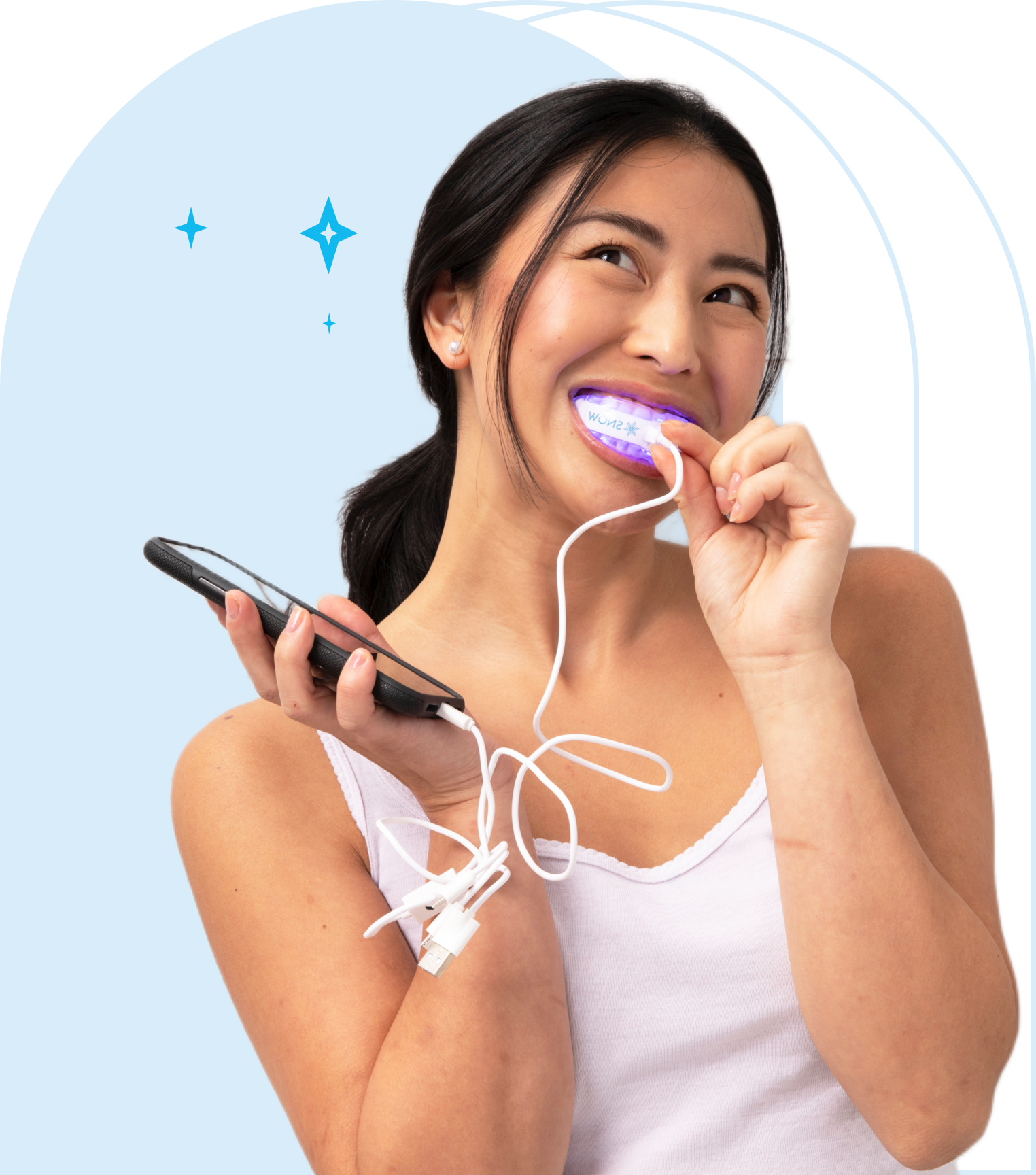Most electric toothbrushes have a lifespan of three to five years, but how you care for yours makes a big difference. In this article, we’ll break down what affects durability and share simple tips to help extend your toothbrush’s life.
Key Takeaways
-
Electric toothbrushes typically last between three to five years, depending on battery type, motor construction, and environmental conditions.
-
Regularly replacing brush heads every three to four months ensures effective plaque removal and optimal oral hygiene.
-
Proper maintenance, including cleaning, storage, and correct charging practices, significantly extends the lifespan of electric toothbrushes.
What’s the Lifespan of an Electric Toothbrush? (And Why It Varies)
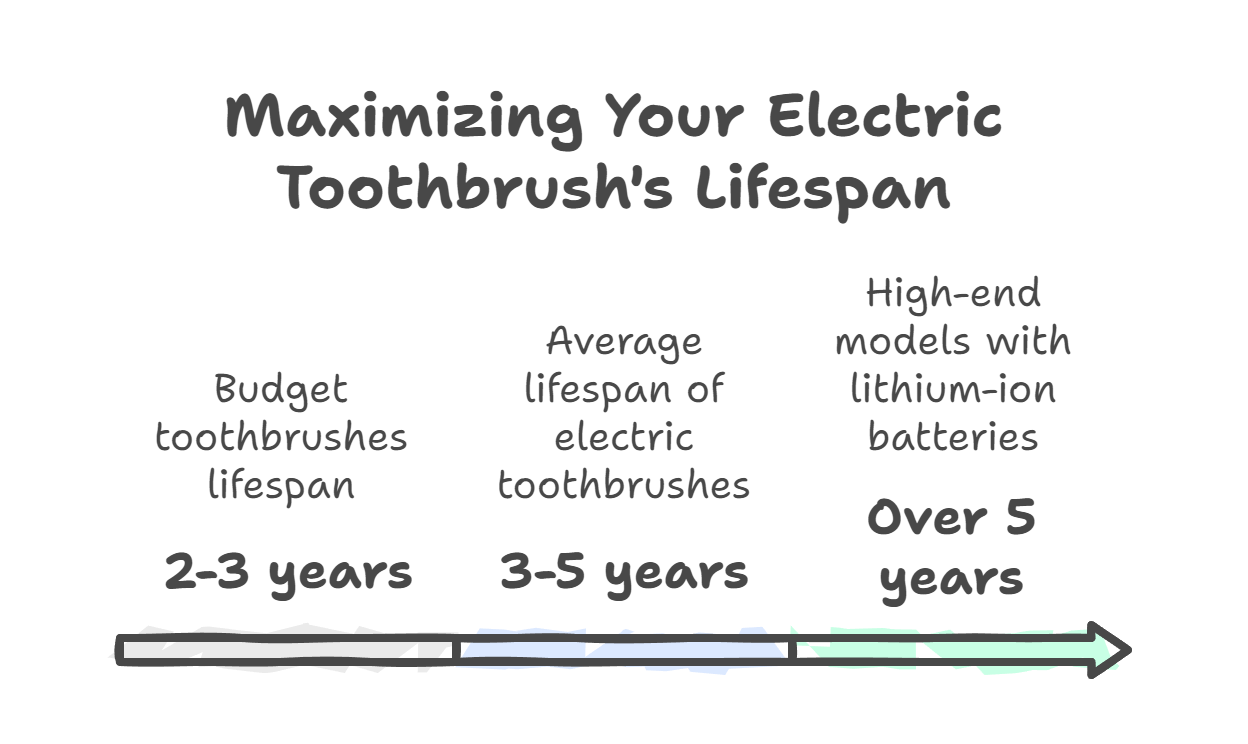
Most electric toothbrushes last three to five years, though the actual lifespan can vary depending on the brand, battery type, and how well the device is cared for.
High-quality models with lithium-ion batteries and durable motor construction often last longer than basic or budget-friendly options. Even so, proper care—like regular cleaning, correct charging habits, and safe storage—can make a big difference regardless of the model.
Here’s what you can generally expect:
-
Budget toothbrushes may last around 2–3 years.
-
Mid- to high-end models with better materials and build can exceed 5 years.
-
Toothbrushes with replaceable parts or extended warranties offer added longevity and value.
Understanding what affects longevity helps you get the most out of your electric toothbrush and avoid early replacements.
The Importance of Regularly Replacing Brush Heads
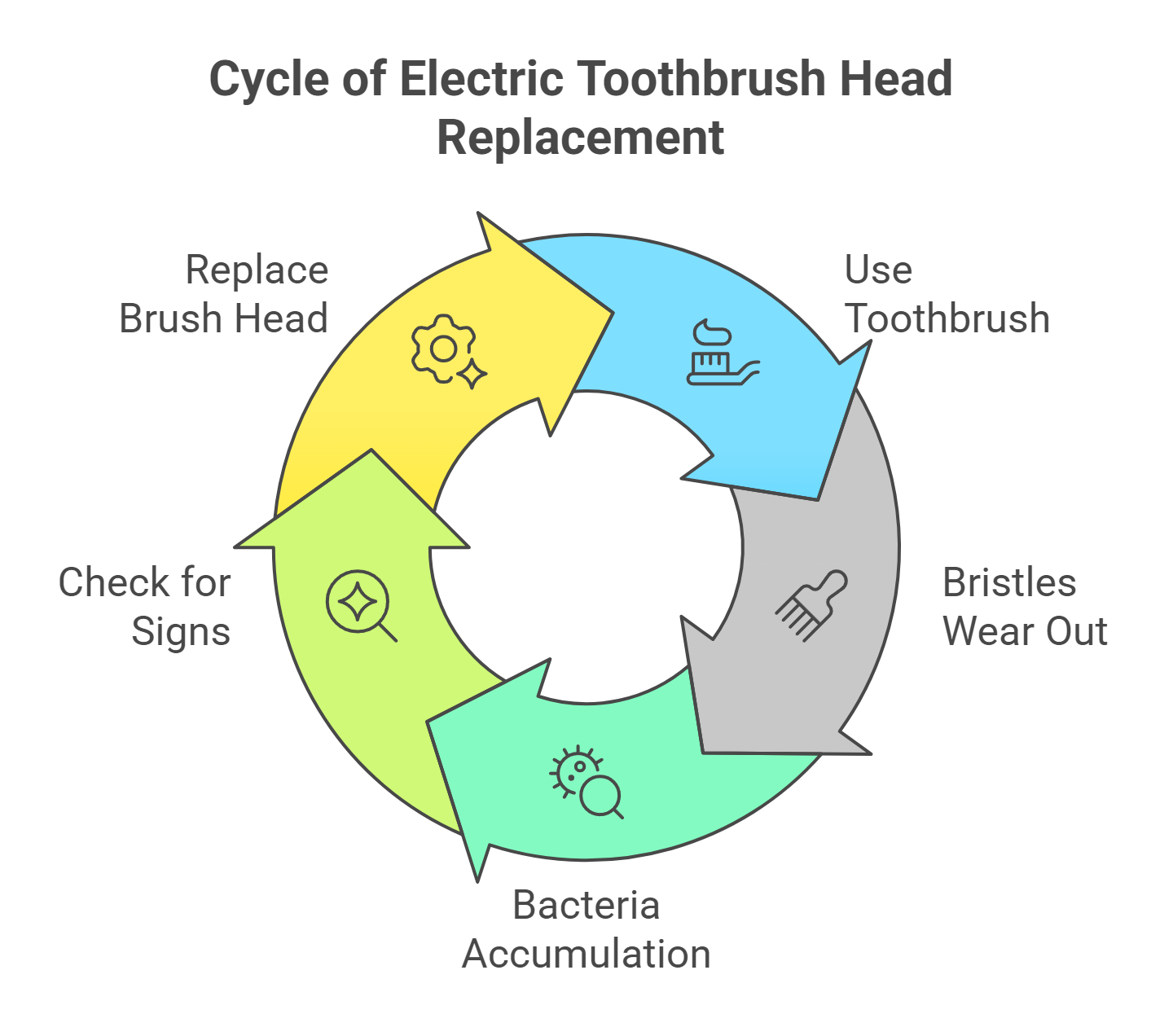
Replacing electric toothbrush heads regularly is essential for maintaining cleaning efficiency and overall oral hygiene. Dentists recommend changing brush heads every three to four months for optimal results. Here's why it matters:
-
Bristles wear out over time, reducing the toothbrush's ability to effectively remove plaque.
-
Worn bristles can lead to less thorough cleaning, increasing the risk of tooth decay and gum disease.
-
Old brush heads may harbor harmful bacteria, especially if used beyond the recommended time.
Many brush heads come with indicator bristles that fade in color to signal when it’s time for a replacement—usually around the three-month mark. You should also replace the brush head after recovering from an illness to avoid reintroducing bacteria into your mouth.
Maintaining a regular replacement schedule helps ensure that your electric toothbrush continues to deliver effective results and supports your overall oral health. And if the handle or motor becomes damaged or the device no longer performs properly, it may be time to invest in a new toothbrush altogether.
How to Know When to Replace Your Brush Head
It’s easy to overlook, but replacing your brush head regularly is essential. Here are the key signs it’s time for a change:
-
Bristles are visibly worn, frayed, or splayed out.
-
Your teeth don’t feel as clean after brushing as they used to.
-
The color of the bristles has faded (many heads include indicator bristles that fade over time).
You should also swap out your brush head after recovering from a contagious illness to avoid reintroducing bacteria. Most dental professionals recommend replacing the head every three to four months—even sooner if these signs appear earlier.
Why Worn Brush Heads Can Harm Your Oral Health
Using an old or worn brush head does more than just reduce cleaning power—it can actually put your oral health at risk. Dull bristles are less effective at removing plaque, increasing the risk of:
-
Tooth decay
-
Gum disease
-
Enamel erosion
Keeping your brush head in top condition is key to effective brushing and maintaining a healthy smile. Replacing it on schedule ensures your electric toothbrush continues to support strong daily hygiene habits.
Key Factors Influencing Electric Toothbrush Longevity
Several factors influence the overall lifespan of an electric toothbrush—including battery type, build quality, usage habits, and the environment it’s stored in. Understanding these variables can help you choose a better device and extend its performance over time.
Battery Type and Charging Habits
The type of rechargeable battery used in electric toothbrushes can significantly affect their longevity. Rechargeable batteries in electric toothbrushes have a limited number of charge cycles, affecting their lifespan. Premium lithium-ion (Li-ion) batteries provide more charge cycles and slower degradation compared to older Nickel-Metal Hydride (NiMH) types. Proper charging practices are crucial for maintaining battery capacity and health. For instance, consistently depleting the battery to low levels or overcharging can harm its lifespan. Always follow the manufacturer's instructions for charging your electric toothbrush to ensure optimal battery health and longevity.
Unplugging the toothbrush once fully charged and not leaving it on the charger continuously can prolong the battery’s lifespan. Following proper charging habits can significantly improve the longevity of your electric toothbrush and ensure consistent performance.
Quality of Construction and Materials

Electric toothbrushes made with superior materials are likely to last longer than those constructed from cheaper alternatives. Key factors include:
-
Precision engineering in the motor assembly ensures consistent performance and longevity.
-
High-grade materials minimize friction wear.
-
Toothbrushes made with high-quality, impact-resistant plastics are more durable and can withstand daily use better.
Reputable brands often provide a manufacturer's warranty, which is important as it typically covers defects in materials and workmanship for one to two years.
This warranty coverage ensures support from the manufacturer and can include options for extended warranties, giving you peace of mind about the product's durability and protection against potential damage that could otherwise void the warranty.
Investing in a well-constructed electric toothbrush can provide better long-term value and superior cleaning efficacy compared to manual toothbrushes. Electric toothbrushes provide superior plaque removal compared to manual toothbrushes. Additionally, most manufacturers offer a range of options to suit different preferences.
Environmental Conditions
Environmental conditions such as humidity and temperature play a significant role in the lifespan of electric toothbrushes. High humidity can lead to mold growth, which is the biggest contributor to electrical issues in electric toothbrushes. Extreme temperatures can negatively impact battery performance and affect the overall functioning of the toothbrush.
Storing your electric toothbrush in a clean, dry area away from water and moisture helps prolong its lifespan. Storing the toothbrush upright to air dry completely helps prevent bacterial growth and maintain functionality. Do not share your toothbrush with anyone to prevent cross-contamination.
Brushing Habits and Techniques That Protect Your Electric Toothbrush
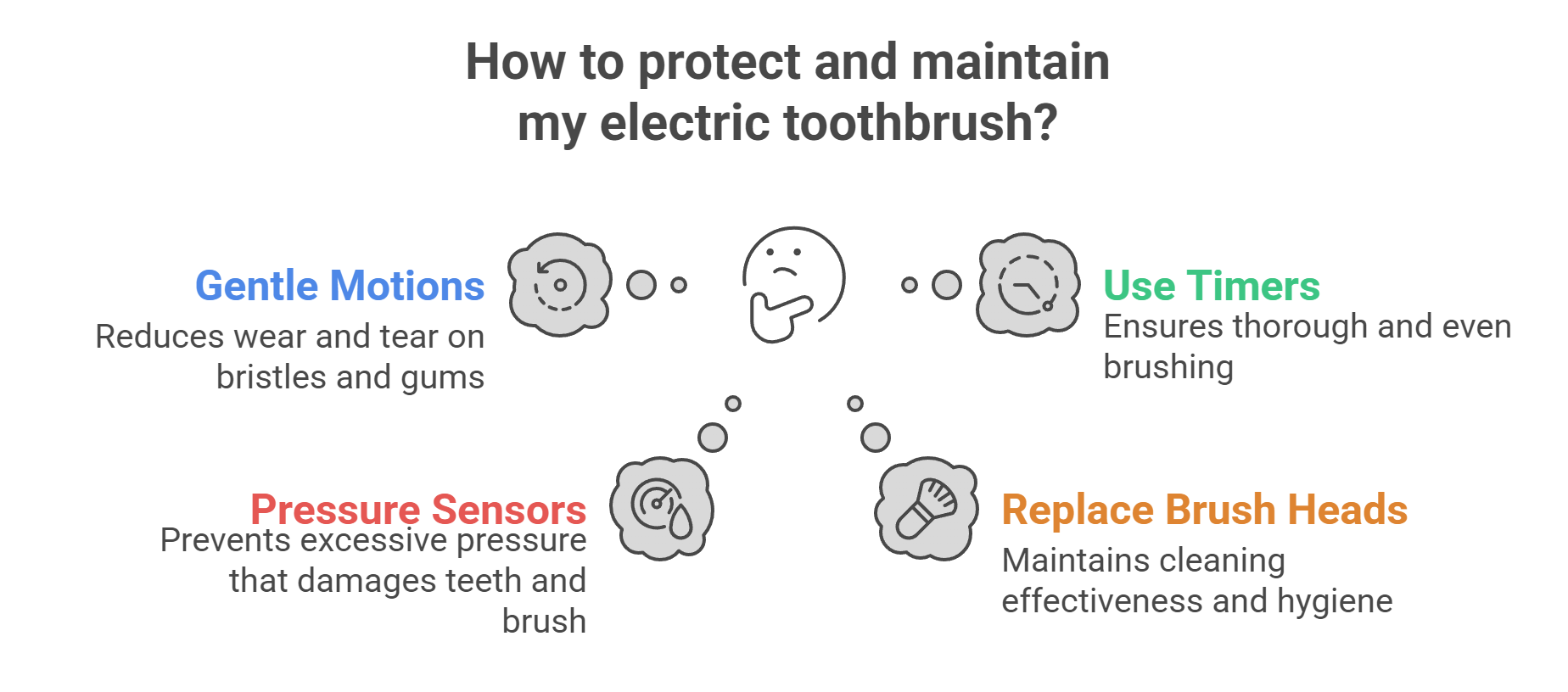
Practicing proper brushing habits not only improves your oral health but also extends the life of your electric toothbrush. Small changes in technique can reduce wear and tear on your device while boosting overall cleaning performance.
Use Gentle, Circular Motions
Instead of aggressive scrubbing, use slow, circular motions and let the toothbrush do the work. Most electric toothbrushes are designed to provide optimal movement and pressure—so there’s no need to push hard. Brushing too forcefully can lead to premature wear of the bristles and may even damage your gums.
Stick to the Dentist-Recommended Routine
Aim to brush for two full minutes, twice daily. Most electric toothbrushes include built-in timers and quadrant pacing (such as 30-second intervals) to help you stay on track. These features ensure that you’re brushing evenly and thoroughly across all areas of the mouth.
Take Advantage of Pressure Sensors
If your toothbrush includes a pressure sensor, use it to your advantage. These built-in alerts notify you when you’re pressing too hard—a common habit that can damage both teeth and the brush head over time.
Replace Brush Heads Regularly
To maintain cleaning effectiveness, replace the brush head every three to four months, or sooner if the bristles are frayed. Worn bristles are less effective at removing plaque and may harbor bacteria that can lead to gum issues or bad breath.
By following the right brushing techniques and leveraging the built-in features of your electric toothbrush, you can maintain better oral health and extend the functional lifespan of your device.
Brushing Modes and Features
Most electric toothbrushes come equipped with a variety of brushing modes and features designed to address different oral care needs. Common brushing modes include daily cleaning, whitening, sensitive teeth, and gum massage, allowing users to customize their brushing experience for optimal oral hygiene and dental health. These modes help ensure that your teeth and gums receive the care they need, whether you’re focusing on gentle cleaning or more intensive plaque removal.
Many electric toothbrushes also offer advanced features such as Bluetooth connectivity, enabling you to track your brushing habits and receive personalized feedback through mobile apps. Pressure sensors are another valuable addition, alerting you if you’re applying too much force and helping you maintain proper brushing technique. Timers built into most electric toothbrushes ensure you brush for the recommended duration, supporting consistent performance and thorough cleaning.
Interchangeable brush heads are a convenient feature, allowing you to switch between different types of heads to match your chosen brushing mode or specific oral care needs. When selecting the right electric toothbrush, consider which brushing modes and features align best with your dental health goals and personal preferences. By making use of these advanced features and regularly changing brush heads, you can maintain optimal oral hygiene, prevent dental issues, and extend the lifespan of your toothbrush for a healthier smile.
Recognizing When Your Electric Toothbrush Needs Replacement
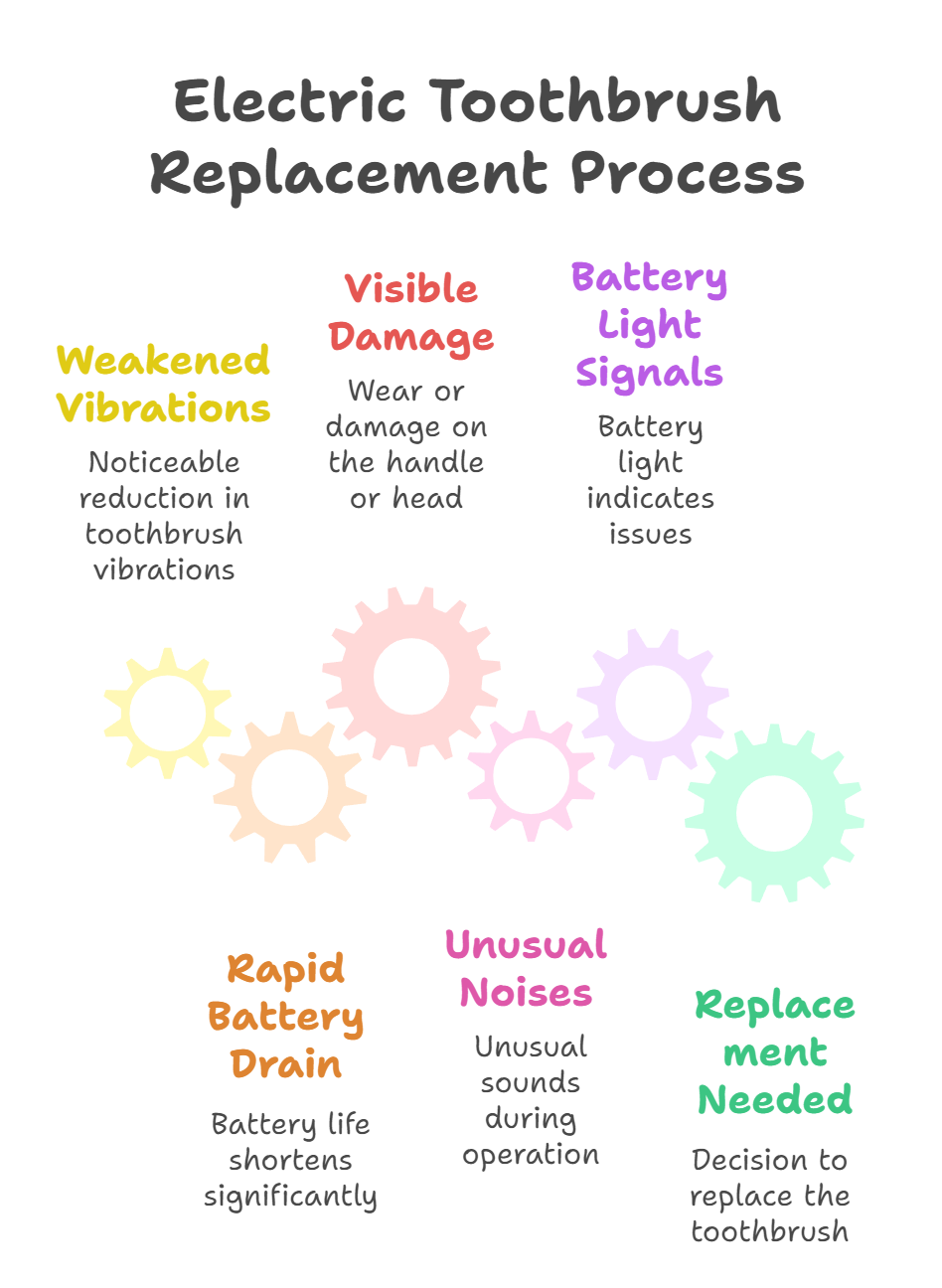
Recognizing when your electric toothbrush needs replacement is crucial for maintaining optimal oral hygiene. Common signs include:
-
Weakened vibrations
-
Rapid battery drain
-
Visible damage
-
Visible wear or damage to the toothbrush handle
A noticeable reduction in vibrations during use suggests that your electric toothbrush may be nearing the end of its effective lifespan.
If the battery life shortens significantly or the toothbrush struggles to maintain a charge, it indicates a need for replacement. The battery light on your electric toothbrush can also signal when the battery needs recharging or if there are battery issues that may require replacing the device. Additionally, unusual noises or vibrations during operation might signal an underlying issue with the toothbrush’s motor.
Visible wear on the handle or head can also indicate that it’s time for a replacement.
Practical Tips for Extending the Lifespan of Your Electric Toothbrush
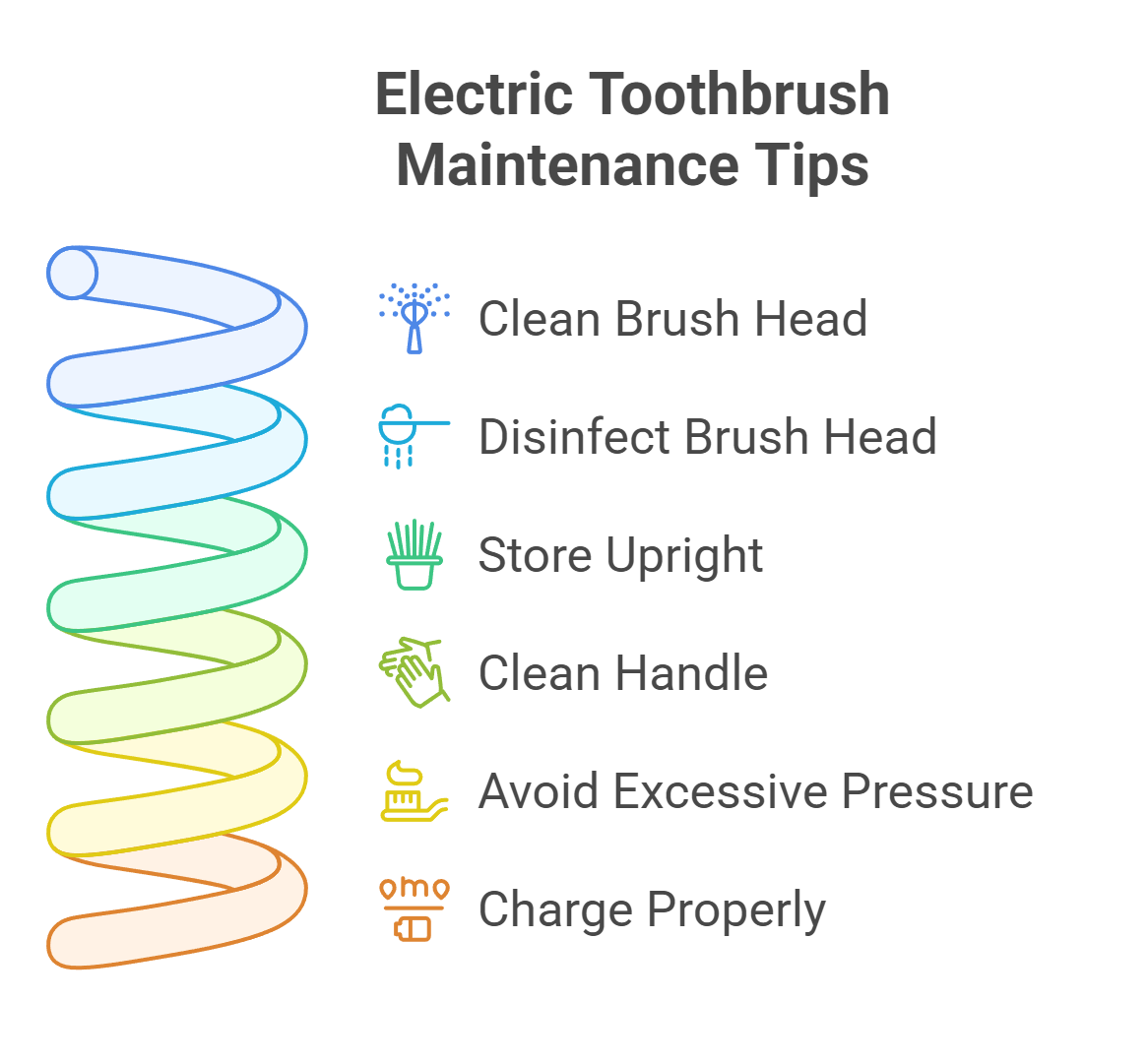
Taking care of your electric toothbrush doesn’t just keep it clean — it directly impacts its performance and longevity. With proper maintenance and smart usage habits, you can easily extend its lifespan while keeping your oral hygiene at its best.
Here are the top tips to help your electric toothbrush last longer:
1. Clean the Brush Head After Every Use
After brushing, rinse the brush head thoroughly under warm water to remove toothpaste, food particles, and bacteria. Rinse your toothbrush head thoroughly after each use. This simple habit helps prevent buildup and preserves the integrity of the bristles.
Bonus Tip: Disinfect the brush head weekly using a mixture of water and hydrogen peroxide or antibacterial mouthwash to reduce bacterial growth.
2. Store Upright in a Dry, Ventilated Space
Let your brush air dry fully by storing it upright in a well-ventilated area. Avoid enclosed containers, as these trap moisture and increase the risk of mold and mildew. If you use a brush cover, make sure the head is completely dry before covering it.
3. Keep the Handle Clean
Wipe down the handle and charging base regularly with a soft cloth. Pay extra attention to the metal contacts or induction pads to ensure a secure and efficient charge.
4. Avoid Brushing with Excessive Pressure
Pressing too hard can wear out bristles faster and strain the motor. Most modern electric toothbrushes include pressure sensors that alert you if you're brushing too hard — use them to your advantage.
Pro Technique: Use slow, gentle motions and let the toothbrush do the work. Aggressive brushing doesn’t mean better results — it just shortens the life of your brush and could irritate your gums. For people with sensitive teeth and gums, a teeth whitening pen is a gentle alternative for a brighter smile.
5. Charge the Right Way
Battery health is critical to your toothbrush’s lifespan. Follow these key practices:
-
Let the battery drop to around 20% before recharging.
-
Unplug the toothbrush once it's fully charged.
-
Avoid keeping it docked on the charger 24/7.
Emerging Trends in Electric Toothbrush Technology
The world of electric toothbrushes is constantly evolving, with new technologies emerging to enhance oral care. Some electric toothbrushes now offer additional features that connect to apps, providing real-time feedback about brushing habits and areas that may require more attention.
Electric toothbrushes often feature timers to ensure proper brushing duration. Bluetooth connectivity enables toothbrushes to offer guidance and feedback directly through associated mobile applications and other electronic devices.
Innovations such as UV-LED sanitizers that eliminate bacteria on brush bristles and future potential for cloud integration for comprehensive tracking of oral health trends and dental health are also on the horizon. These advancements are set to revolutionize the way we approach dental hygiene and ensure a healthier smile.
How to Choose the Right Electric Toothbrush
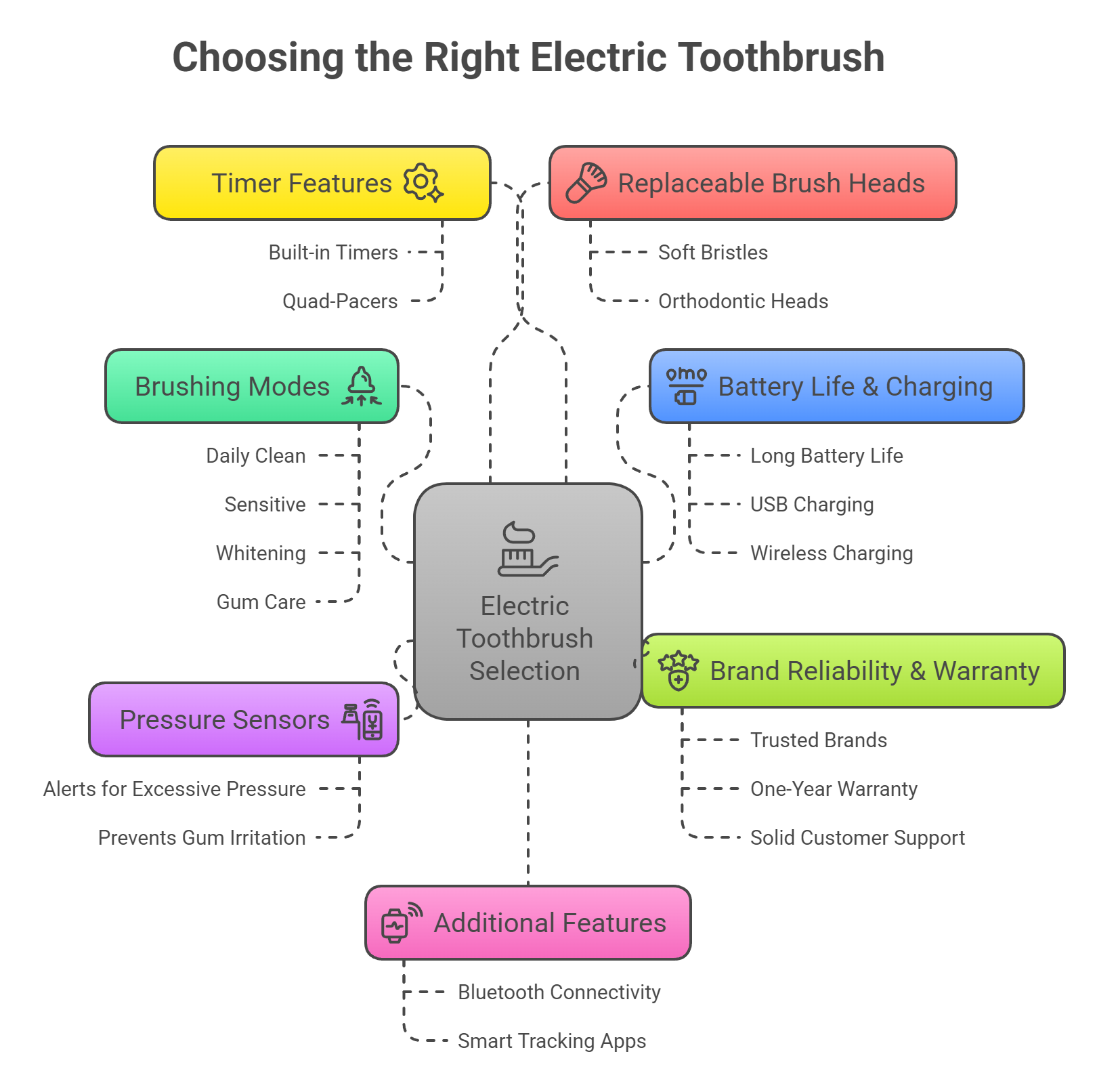
Choosing the right electric toothbrush can make a big difference in your daily oral care routine. To find the best fit for your needs, focus on features that match your dental concerns, lifestyle, and preferences.
Here’s what to consider when selecting an electric toothbrush:
-
Brushing Modes: Look for models with multiple modes like Daily Clean, Sensitive, Whitening, or Gum Care. These options let you tailor your brushing experience based on your oral health needs.
-
Pressure Sensors: A good electric toothbrush should help protect your gums. Built-in pressure sensors alert you if you're brushing too hard—important for preventing gum irritation and bristle wear.
-
Timer Features: Dentists recommend brushing for two minutes. Most modern electric toothbrushes have built-in timers or quad-pacers that help you stick to the correct brushing duration.
-
Battery Life & Charging: If you travel often, go for a model with long battery life and USB or wireless charging. Lithium-ion batteries generally last longer and charge faster than older types.
-
Replaceable Brush Heads: Choose a toothbrush compatible with a variety of brush heads (e.g., soft bristles, orthodontic heads). This adds flexibility and value over time.
-
Brand Reliability & Warranty: Stick with trusted brands that offer at least a one-year warranty and solid customer support. A quality build ensures better durability and long-term performance.
-
Additional Features: Some high-end models include Bluetooth connectivity or smart tracking through an app to monitor brushing habits—great if you're looking for detailed feedback.
By keeping these factors in mind, you’ll be better equipped to choose an electric toothbrush that supports both your short-term oral hygiene and long-term dental health goals.
Summary
In summary, understanding the lifespan of electric toothbrushes and the factors that influence their longevity is essential for maintaining optimal oral hygiene.
Regularly replacing brush heads, recognizing signs of wear, and adhering to proper maintenance practices can significantly extend the operational life of your electric toothbrush.
Patients who use electric brushes tend to focus better while brushing, which can lead to improved oral care outcomes. By choosing high-quality models and following recommended care guidelines, you can ensure that your toothbrush remains effective and provides better long-term value.
As we embrace emerging trends in electric toothbrush technology, staying informed about the latest innovations can help enhance our oral care routines. By applying the knowledge and tips shared in this guide, you can achieve a healthier smile and maintain excellent dental hygiene for years to come.
Explore SNOW electric toothbrush
Frequently Asked Questions
How often should I replace my electric toothbrush head?
To maintain optimal cleaning effectiveness and hygiene, it's important to replace your electric toothbrush head every 3 to 4 months. Regularly doing so will ensure that your oral health remains a priority. This practice helps prevent bacterial overgrowth and maintains oral hygiene.
What are signs that my electric toothbrush needs to be replaced?
Your electric toothbrush needs to be replaced if you notice weakened vibrations, rapid battery drain, unusual noises, or visible damage. It's essential to maintain oral hygiene with a fully functioning toothbrush. Visible damage or cracks on the handle or charger are clear indicators that the toothbrush needs to be replaced.
How can I extend the lifespan of my electric toothbrush?
To extend the lifespan of your electric toothbrush, ensure you clean it regularly, avoid applying excessive pressure while brushing, and adhere to proper charging practices. This will promote optimal performance and longevity.
What factors influence the longevity of an electric toothbrush?
The longevity of an electric toothbrush primarily depends on the battery type, quality of construction, environmental conditions, and your maintenance habits. Ensuring proper care and storage can significantly enhance its lifespan.
Are there any emerging trends in electric toothbrush technology?
Emerging trends in electric toothbrush technology include app connectivity for real-time feedback, UV-LED sanitizers, and potential cloud integration for oral health monitoring. These advancements enhance user experience and promote better oral hygiene practices.















































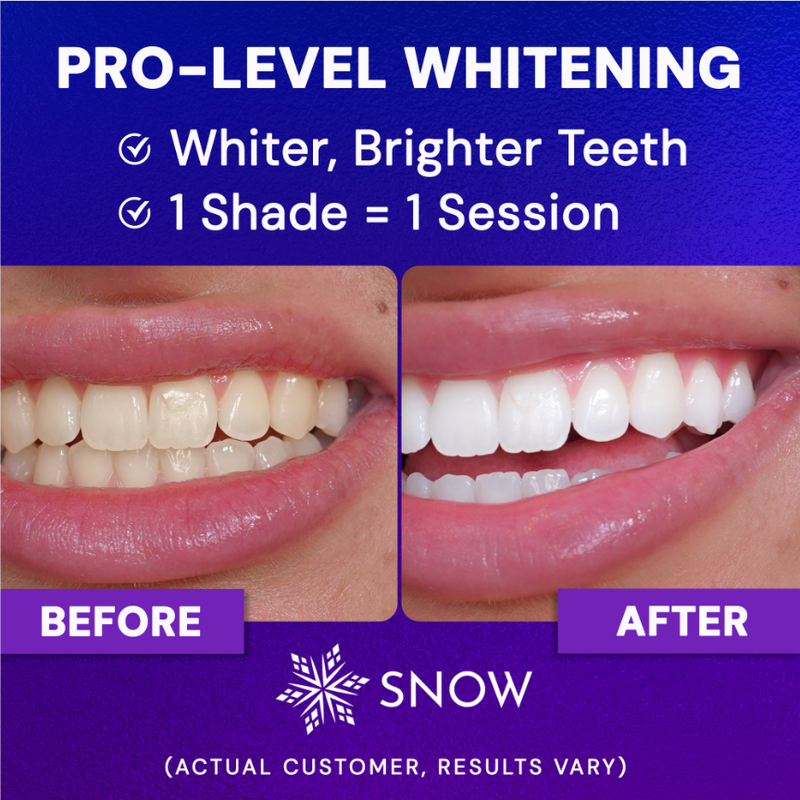
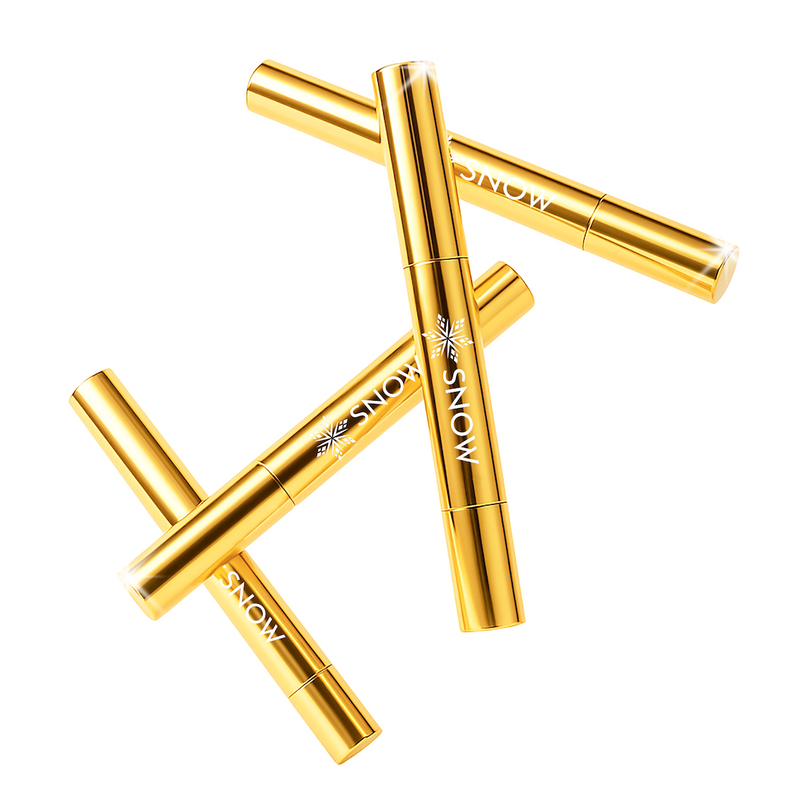
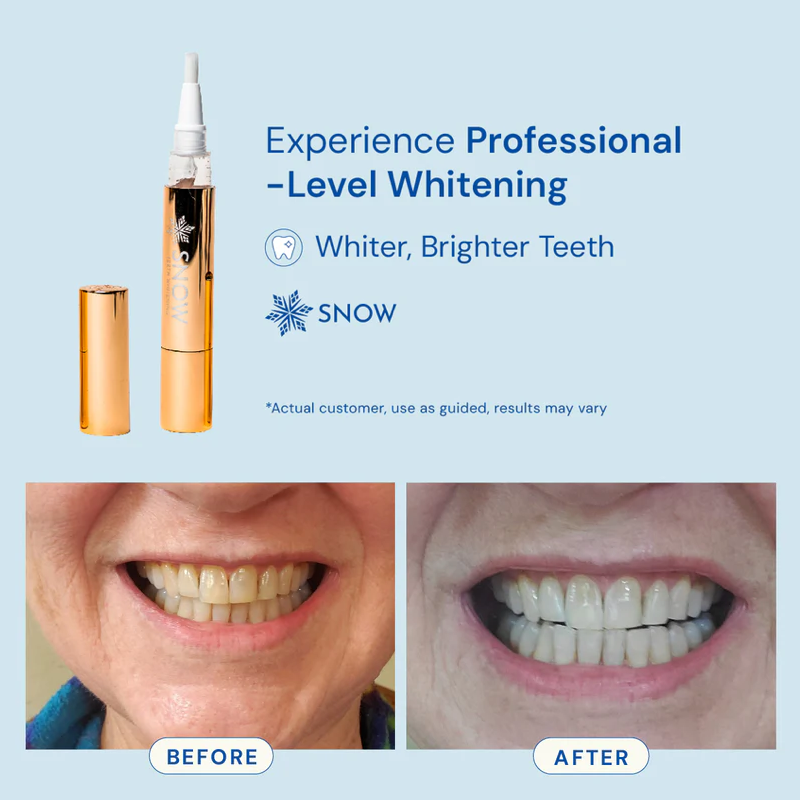


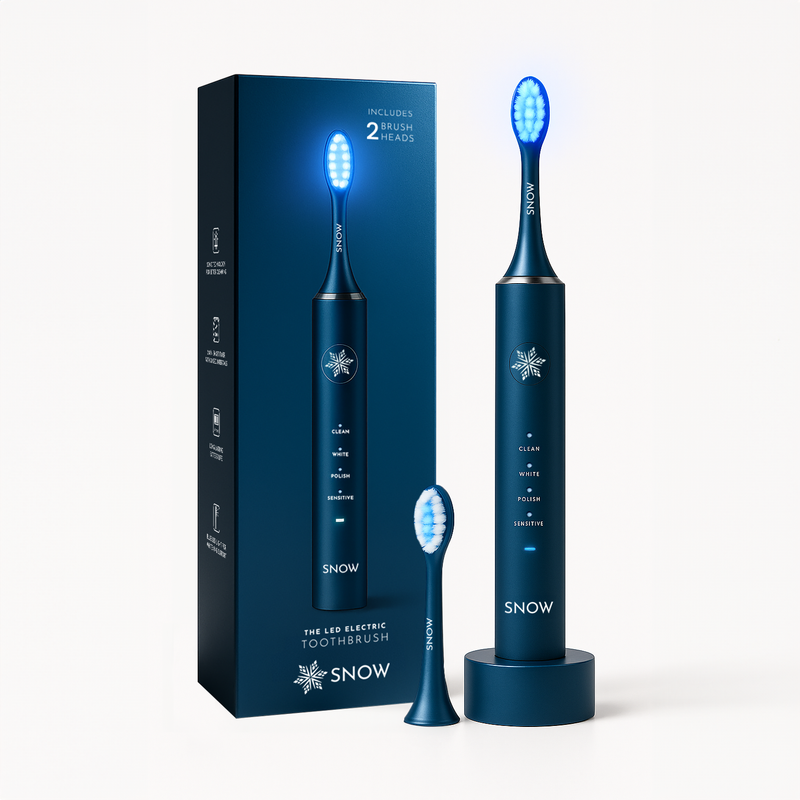


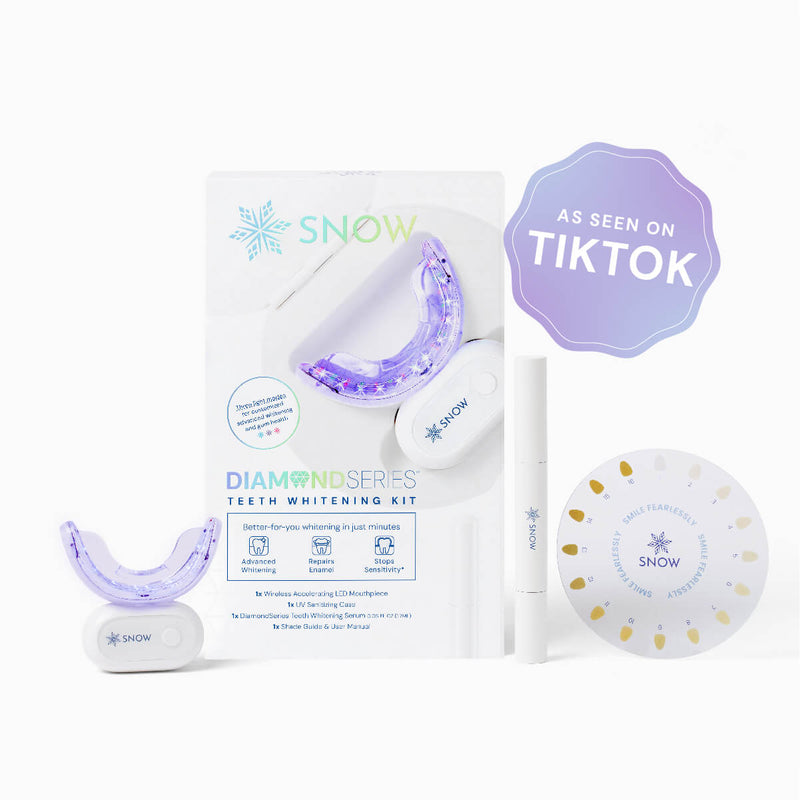
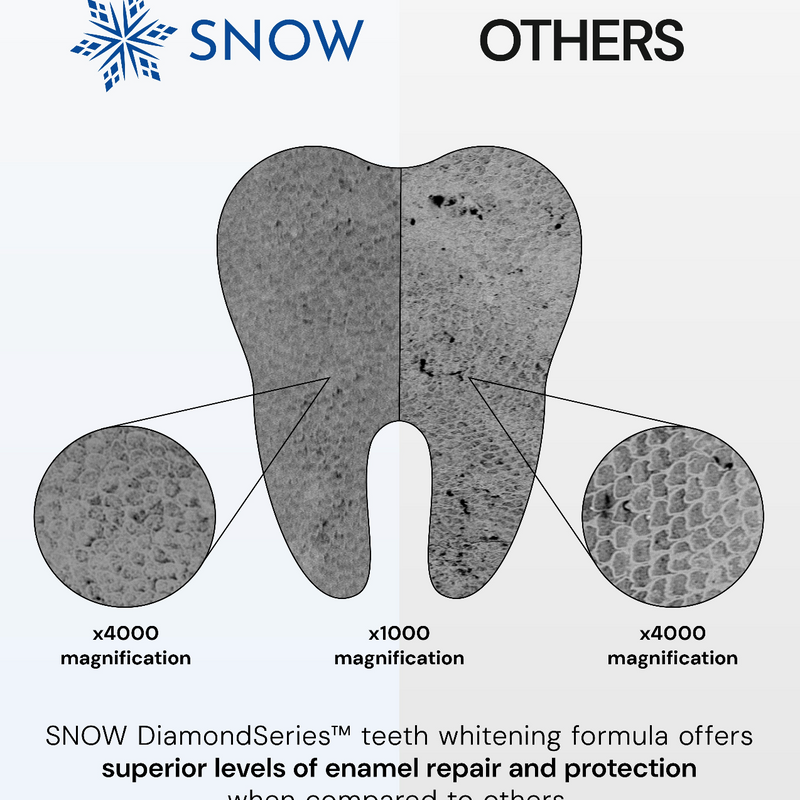











![Clove Oil for Toothache Relief [Does it Really Work]](http://www.trysnow.com/cdn/shop/articles/clove_oil_for_toothache_does_it_really_work.png?v=1756135924)
